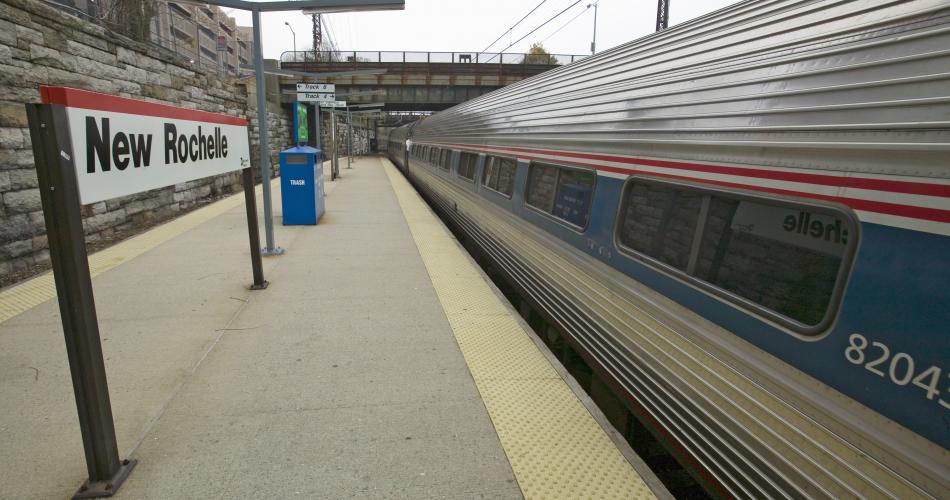Reading time: 8 minutes
New Rochelle’s story was told by the City of New Rochelle’s Commissioner for Development, Luiz Aragon, at a briefing on the Build More Housing Near Transit Act, hosted by Up for Growth Action in the Cannon House Office Building in Washington, DC on January 16. As Aragon told the crowd of Congressional staff and other stakeholders, New Rochelle is an example of how up front and holistic planning can fully utilize a community’s transit resources – and spur affordable housing development near train stops and other walkable amenities.
“The City of New Rochelle understood the tremendous opportunity created by easy access to transit and untapped potential in our downtown,” said Aragon. “The rezoning effort the city embarked upon has spurred unprecedented new development, boosting housing supply, improving affordability, and reinvesting in needed community programs. Just as important, it was a collaborative approach, relying on community input and coordination with the private sector. I’m excited to share New Rochelle’s story and hope it’s a model for others to follow.”
Prior to the unanimous passage of the downtown redevelopment plan by the City Council in 2015, only one new building had been built in downtown New Rochelle in the previous 10 years. Though a significant portion of the town’s growth and retail activity had moved away from the center city in the previous decades, extensive research and community engagement led to the realization that many city residents were not happy with their downtown. Just as important, New Rochellians wanted to do something about it. It also helped that the proposed redevelopment did not impact the primarily single-family neighborhoods where most in the city currently live.
In addition, New Rochelle faces a growing housing affordability challenge. With an area median income of $120,000 for a family of four (in Westchester County), many New Rochellians – including public servants like police, firemen, teachers, and nurses – have difficulty finding housing they could afford.
The plan that ultimately came to fruition consisted of five primary elements:
- A form-based code that simplified zoning and established density without mandating use.
- Streamlined process that guarantees project approvals within 90 days, targeted to get shovels in the ground within two years.
- A community benefit bonus for additional density that encourages developers to incorporate open space, additional affordable housing, historic restoration, and other measures into their projects.
- Fair share mitigation with fixed fees that ensures the funding of vital community services and infrastructure.
- A pilot 20-year tax abatement program in exchange for additional affordable housing units.
In addition to community input, the city brought developers and the private sector to the table to ensure its plans would pencil out. It was a true partnership; developers covered the cost of the required environmental review. Philip Wharton of New York-based Twining Properties identified some key reasons he believes New Rochelle’s model has been so successful:
- Political will and city-level leadership, including city staff.
- Early engagement with the private sector and public-private partnership.
- Community involvement from the beginning.
- Strong pent-up demand for investment due to New Rochelle’s existing attributes.
The on-the-ground results are impressive. In the last four-plus years, 32 projects totaling $4 billion in investments have been approved, which includes 6,300 new units, 770 of which are set aside as affordable. Over 245,000 square feet of nonresidential development is in some stage of development. Its pilot tax abatement program on 12 properties increased revenue from $30 million to over $200 million, both over 20-year periods. The properties are projected to generate over $530 million in tax receipts over a 20-year period once the program expires. The community benefit bonus created the First Source Referral Center employment center that has already placed over 330 New Rochellians in jobs, with nearly half of those located within the city.
The city’s initial goal was to create 5,500 new units under the new plan. It has well already exceeded that number, with 3,000 – 4,000 additional units expected in the future. In the case of New Rochelle, if you plan for it, they will build it.
New Rochelle’s approach has been profiled in numerous national outlets, including a Wall Street Journal story with a subhead that read “City makes most of train station’s location, paves the way for new stores, restaurants and apartments,” and an observation that captures the spirit of what New Rochelle is trying to achieve: “Elected officials and developers believe the city is poised to take advantage of the global trend of urbanization, attracting millennials priced out of New York City as well as empty nesters in the region.”
According to Aragon, the most important takeaway is the importance of planning. “Location. Location. Location. But simply having location isn’t enough. You have to have a plan.”
ECONorthwest’s Dr. Ian Carlton, who joined Aragon at the Congressional briefing, would certainly agree with this assessment. His presentation focused on the current transit-near-housing landscape, concluding that many transit projects are not optimized for density. The reason for this lack of density is in large part because current transit planning practices often do not accurately account for housing feasibility near transit stops, a subject on which he has completed extensive research. The Build More Housing Near Transit Act seeks to incentivize transit planners to use what are effectively real estate pro formas, increasing the likelihood that transit will indeed lead to more housing. You can check out Ian’s research and presentation by clicking here.
The lesson from New Rochelle is that planning development around transit really can work, but it must be done comprehensively and on the front end. And these plans must have buy-in from both the community as well as those who will ultimately build affordable and market-rate housing. The Build More Housing Near Transit Act would encourage such an approach from any city seeking federal funding for New Starts project. If passed, many more areas of the country could see benefits like those New Rochellians are now experiencing.
